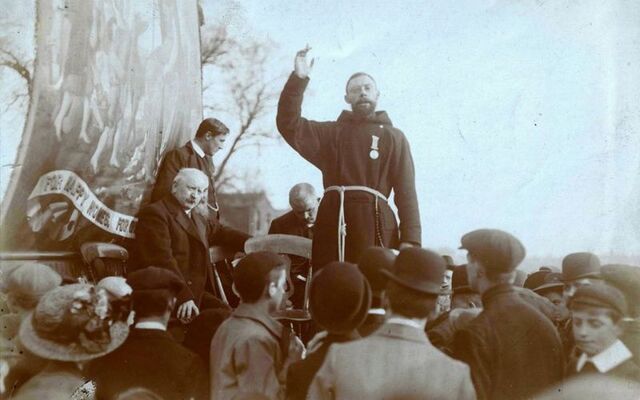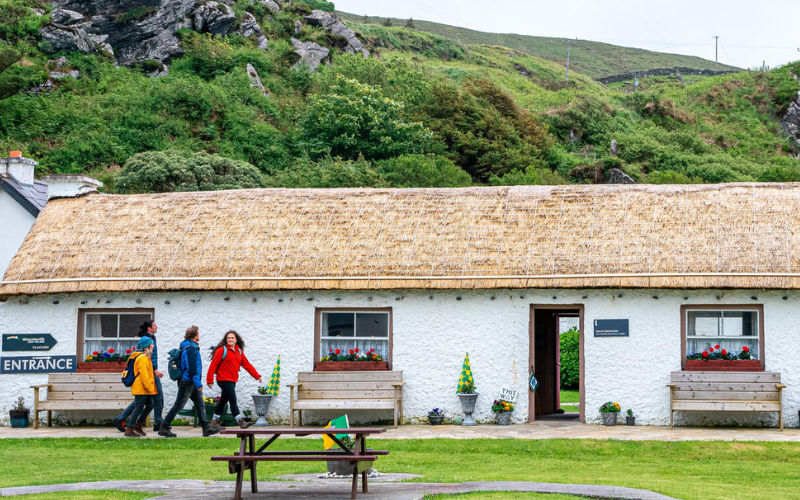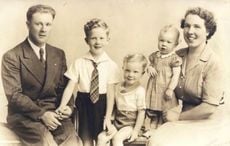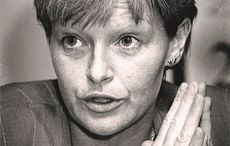The Capuchin Friars of Ireland can trace their history to the Capuchin community at Charleville, France.
Francis Nugent was born in 1569 near Mullingar, and after his education in Paris and Louvain, he joined the Capuchin Order. In the 1590s, he was sent to France where the French Capuchin provinces were being formed at Metz and Charleville. Later, Nugent petitioned Pope Paul V for permission to establish the Order in Ireland. The Friary at Charleville became a center for training Friars for the Irish mission. Irish Friars from all provinces were sent there, and it became the novitiate and alma mater of the province of Ireland.
Brother Stephen Daly became the first Irish Capuchin to return to Ireland in 1615. He was followed by four other Friars who lived separately wherever they could. Finally, in 1624, Fr Francis was able to found the first Capuchin community in Dublin in Bridge Street. That community, however, was seized and conferred upon Trinity College Dublin, and the Friars had to return to the country.
The Order continued to grow in Ireland, establishing themselves in Cork in 1637 and by 1642 there were 51 Friars, with houses in Dublin, Slane, Limerick, Mullingar, Drogheda, and Cork. In 1643 they set up a community in Kilkenny, and in 1645 a hospice in Wexford.
In 1649, Archbishop Edward Walsh of Kilkenny wrote to Pope Clement XI praising the Capuchins. This was the year that Cromwell arrived in Ireland. Wexford was sacked and under the Cromwellian regime, a new wave of persecution ensued, in which religious were especially targeted.
In spite of persecution, the Order continued to grow. By 1733, the Capuchins had 14 houses in Ireland and two in France, and were made a “province”.[1]
The 19th Century marked a period of outreach and growth for the Irish Capuchins. The Capuchins officially opened a “Seraphic College,” a school with a Franciscan ethos, aimed at fostering vocations to the Order, in Kilkenny on 8 December 1884. The school was transferred to Rochestown, County Cork two years later. Rochestown became a center for promoting the Gaelic cultural revival.
Since the re-establishment of the Irish Province of the Capuchin Order in 1885, there had been strong links between its members and the emerging national movement. It was clear that the cultural resurgence associated with the “Irish Ireland” movement deeply influenced the men who were drawn to Capuchin's religious life.
Religious restrictions, class immobility, and a lack of Irish cultural recognition still characterized Ireland in the late 19th century, but the re-emerging pride of the Irish people capitalized on the energy and zeal of a younger generation of Irish nationalists.
Concurrently, there was a revival of both Irish games and Irish cultural studies throughout the country. In the 1880s, many, including Archbishop Thomas W. Croke, maintained that “ball-playing, hurling, football kicking according to Irish rules ... may now be said to be not only dead and buried but in several localities to be entirely forgotten. What the country needed was an Irish organization to bring order and unity to sport on a nation-wide basis”.[2]
In August 1884, Michael Cusack outlined to a group of local athletic enthusiasts his plans to establish a national organization for Irish athletes and to revive hurling.
On 1 November 1884, the Gaelic Athletic Association (GAA) was founded. Similarly, the Gaelic League was founded by Douglas Hyde, Fr Eugene O’Growney, Fr Michael Hickey, and Eoin MacNeill on 31 July 1893 as a non-political, non-sectarian organization dedicated to the preservation and revival of the Irish language, and the “celebration of, and if possible the resuscitation of, traditional dress, dances and customs”. [3] [4]
The Gaelic League quickly had a major impact on the social life of Ireland. It was responsible for giving the Irish language a prominent position in the national school system, it revived Irish poetry, drama, and literature, and after 1903, St Patrick’s Day became a national holiday; and to the Gaelic League is due the credit of “having established the first Irish national society that accepted women as members on the same terms as men”.[5]
The Irish people began to recognize and take pride in, their Irish culture. “Celtic Dawn” was an accurate description of the changes in many levels of Irish society. As injustices were rectified and educational and economic opportunities were created, some of the growth and cultural expansion that had been halted by the Act of Union re-emerged.[6]
This cultural renaissance, advanced by both the GAA and the Gaelic League, led to an increasing desire for Home Rule. Irish separatists at this time still primarily promoted a “constitutional” solution to their aspirations, rather than the “physical force” solution fostered by the Irish Republican Brotherhood.
Even before the Province was re-constituted, Fr Albert Mitchell, an ardent nationalist, made a particular point of always wearing Irish-made garments and vigorously championed home-made products.
Later, Fr Aloysius Travers preached a “buy Irish Campaign.”
Fr Edwin Fitzgibbon played a leading role in promoting Gaelic games.
Many of the Friars were fluent Irish speakers and Fr Augustine Hayden and Fr Albert Bibby were to the forefront in fostering interest in the native language through the Gaelic League (Conradh na Gaelige).
The Order’s dedication to an “Irish Ireland” extended to the revival of nationalistic thought, as well as to the cultural revival, including those who ministered to men who were advocating separatism from Britain by physical means. In contrast, the Catholic Church was uniformly opposed to any physical force action against the British, and the majority of Catholic bishops remained loyal to moderate and constitutional politics.
That delineation became clear in the Easter Rising of 1916, when the Capuchin Friars were present in many of the garrisons, heard confessions, and ministered to the men and women fighting.
After the Rising ended, from 3 May to 14 May 1916, 14 leaders of the Rising were executed in Kilmainham Gaol. All were given succour by priests in their cells prior to execution. The first three to be executed, Padraic Pearse, Thomas Clarke, and Thomas MacDonagh did not receive the Last Rites after their executions because of the orders of the Gaol Commandant – but all the others did. (James Connolly, imprisoned in Dublin Castle until he was taken to the Stonebreaker’s Yard to be shot, was seen in the Castle).
Most of the Friars who attended those to be executed came from the Capuchin Franciscan Friary of the Church of St Mary of the Angels, located at 138–142 Church Street. Adjacent to the Priory, at 131–137 Church Street, was Fr Mathew Hall, also known as Capuchin Hall. The Hall was used as a hospital during Easter Week. There is a plaque on the wall commemorating its importance during the Rising, as it was the headquarters of the 1st Battalion under Cmdt Edward (Ned) Daly before the Battalion moved to the Four Courts on Friday. The Friars who attended those executed in Kilmainham Gaol lived here, and they were instrumental in bringing the British and the Battalion O/Cs together at the end of the Rising. Fathers Albert Bibby, Aloysius Travers, Augustine Hayden, Columbus Murphy, and Sebastian O’Brien accompanied the various men and women carrying the cease-fire orders, and they also ministered to the leaders in Richmond Prison, Arbour Hill Detention Barracks, and Kilmainham Gaol.
The efforts of the priests were recognized by the survivors, and they paid all the priests the highest compliments. Of Fr Augustine and Fr Albert, Áine Ceannt wrote “…I think enough praise could not be given to both Father Augustine, O.F.M. Cap., and to his comrade Father Albert, for all they did for the executed men”.[7]
And after seeing her brother Micheal O’Hanrahan, his sister Eily wrote: “Micheál said he had asked for Father Augustine and Father Albert. These priests were marvelous. They saved the reason of many people whose Sons and brothers were executed. Father Aloysius and Father Sebastian were very good too. The two former used to come and see us regularly, sometimes they came twice a day in a cab”.[8]
Priests throughout Dublin ministered to the Irish during the fighting, but the Catholic Church was uniformly opposed to any physical force action against the British, and the majority of Catholic priests and bishops remained loyal to moderate and constitutional politics.
Of the 31 bishops in Ireland at the time, only one (Dr. Michael Fogarty of Killaloe) gave a hedged condemnation of the Rising, and one other (Thomas O’Dwyer, Bishop of Limerick) could be said to have partially condoned it. Dr. William Walsh, Archbishop of Dublin, had expressed nationalist feelings, but he thought the Rising “madness." Moreover, the Church had been one of the staunchest opponents of James Larkin, and Connolly’s socialism was anathema to the Church hierarchy.
The Catholic Church held that traditionally there were five conditions required for a lawful revolt:
- A tyrannical government, without legitimacy in the country
- The impossibility of removing that government except by force
- The evil caused by the revolt is far less than that to be removed by the revolt
- Serious possibility of success
- Approval of the community as a whole
The Church’s hierarchy, under the leadership of Michael Cardinal Logue, Bishop of Armagh and Primate of All Ireland, held that the Rising was unjustified because none of the required conditions was met.
Many of the priests completed Witness Statements at the Bureau of Military History, and the Capuchin Friars noted their memories in various issues of the Capuchin Annual.
Footnotes:
[2] Ó Dubghaill, M. Insurrection Fires at Eastertide, (1966), p. 17.
[3] Garvin, Tom. Nationalist Revolutionaries of Ireland, 1858-1928, (1987), p. 79.
[4] A precursor to the Gaelic League was the Society for the Preservation of the Irish Language founded in 1877 by Archbishop John MacHale of Tuam, Archbishop Thomas Croke, and Dr William Walsh, President of St Patrick’s Institute in Maynooth, and later Archbishop of Dublin.
[5] Wyse-Power, Jenny. ‘The Political Influence of Women in Modern Ireland’, in Fitzgerald, William G. editor. The Voice of Ireland, (1924), p. 159.
[6] Coogan, Tim Pat. 1916, The Easter Rising, (2001), p. 29.
[7] Ceannt, Áine B.E. Witness Statement 264.
[8] O’Reilly, Eily O’Hanrahan. Witness Statements 270, 415.
This article was submitted to the IrishCentral contributors network by a member of the global Irish community. To become an IrishCentral contributor click here.




Comments